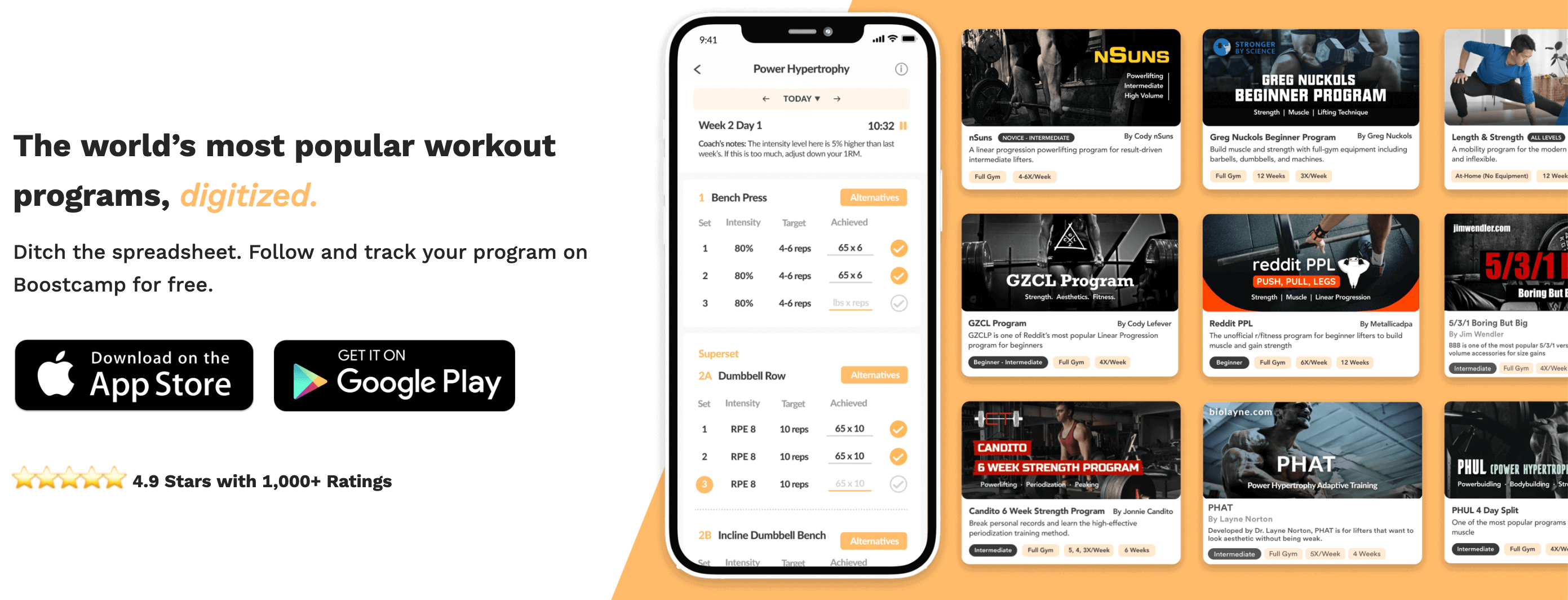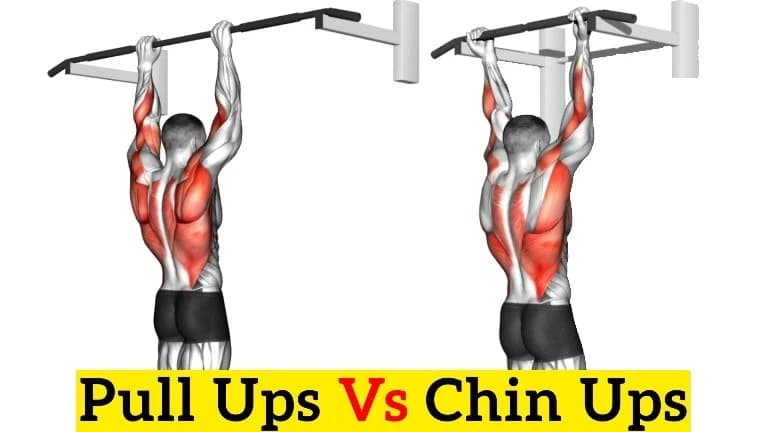Pull-Ups vs. Chin-Ups: Which is the Ultimate Upper Body Builder?
Written by The Boostcamp Editors
Pull-Ups vs. Chin-Ups: Which is the Ultimate Upper Body Builder?
You've probably heard it before: the age-old debate of pull-ups vs chin-ups and which one brings more strength and muscular benefits to the table. Which one is the ultimate upper body builder? Should you include one over the other in your workout routine if you are trying to build muscle mass and strength? In this comprehensive guide, we'll dive into the differences between these two popular exercises, compare their benefits, and help you decide which one to incorporate into your workout routine, whether your goal is a strength sport such as powerlifting or something more aimed at aesthetics like bodybuilding. Plus, we'll introduce you to the Boostcamp App - your new favorite workout tool for tracking your progress as well as customizing your fitness journey.
Both exercises offer relatively equal challenge and are fantastic choices for strengthening the muscles of the upper body. That said, one may be a better choice for you depending on your specific goals, and one may feel easier depending on your current strength routine, body proportions, and muscle firing patterns. The short answer is that both pull-ups and chin-ups provide similar challenges and benefits for the upper body muscles.
Table of Contents:
What are Pull-Ups and Chin-Ups?
How to Perform Pull-Ups and Chin-Ups
Why Include Pull-Ups and Chin-Ups in Your Workout Routine
Pros and Cons of Pull-Ups vs. Chin-Ups
Importance of Pull-Ups and Chin-Ups in a Workout Program
Frequently Asked Questions (FAQ)
Conclusion
Boostcamp App: Your Ultimate Workout Companion
What are Pull-Ups and Chin-Ups?
Pull-ups and chin-ups are both effective upper body compound exercises that target different muscle groups, but both place a large emphasis on the back muscles. They are similar in execution but differ in grip and muscle activation. Pull-ups are performed using an overhand grip, where your palms face away from you. This exercise primarily targets your latissimus dorsi (lats), while also working your biceps, rear deltoids, and core muscles.
Chin-ups, on the other hand, are performed using an underhand grip, with your palms facing towards you. This variation emphasizes your biceps, while still engaging your lats, rear deltoids, and core muscles.
Both exercises will also engage your forearms, as you are gripping the bar. However, you can always incorporate lifting straps to get more repetitions in, but it will take out a lot of the forearm engagement.
How to Perform Pull-Ups and Chin-Ups
To perform a pull-up or chin-up, follow these steps
Find a sturdy horizontal bar, such as a pull-up bar or a playground bar. Make sure it can support your weight.
For pull-ups, grip the bar with an overhand grip, palms facing away from you. For chin-ups, use an underhand grip, palms facing towards you. Place your hands shoulder-width apart.
Hang from the bar with your arms fully extended, allowing your body to be in a dead hang position.
Engage your core and pull your body upward, keeping your elbows close to your body. Continue to pull until your chin is above the bar.
Slowly lower yourself back down to the starting position, maintaining control throughout the movement.
Repeat the exercise for the desired number of repetitions.

Source: https://www.strengthlog.com/
Why include Pull-Ups and Chin-Ups in Your Workout Routine
Both pull-ups and chin-ups are compound exercises, meaning they work multiple muscle groups simultaneously. This makes them highly efficient for building upper body strength and improving overall fitness. Additionally, they:
Improve grip strength
Enhance functional fitness
Develop muscle definition
Increase back and shoulder stability (reduces risk of injury)
Promote better posture
Pros and Cons of Pull-Ups vs. Chin-Ups
Pull-Ups
Pros:
Targets the lats more effectively
Promotes a wider back and V-shaped torso
Develops forearm and grip strength
Cons:
Can be more challenging for beginners
Less emphasis on the biceps
Chin-Ups
Pros:
More bicep engagement
May be easier for beginners
Provides a balanced upper body workout
Cons:
Less focus on the lats
May cause wrist discomfort for some individuals
Importance of Pull-Ups and Chin-Ups in a Workout Program
Incorporating pull-ups and chin-ups into your workout program can be highly beneficial for overall upper body development and muscle gains. Many times, they are incorporated on a "back day" or "pull day", as pull-ups and chin-ups will recruit similar muscle groups to things like rows and deadlifts. They provide an effective way to build muscle mass, improve functional strength, and increase endurance.
By regularly including both exercises in your routine, you can ensure a well-rounded approach to upper body training, targeting multiple muscle groups and promoting balanced muscle development. Over time, pull-ups will result in significant muscle gains in the entire upper body, including the upper back, arms, core, and shoulder-stabilizer strength. Additionally, pull-ups and chin-ups help with decompression of your spine, opening your chest up, and strengthening your shoulder joint complex, thus increasing shoulder mobility and range of motion.
Where to Find Good Training Routines
When it comes to doing Smith machine squats, finding a good workout app with great programs to help you build up your muscle mass and strength and improve overall, check out the free Boostcamp App. You can find tons of different workout routines that will truly push you to the limit, and they are made by renowned evidence-based coaches. Boostcamp also lets you create your own custom routines and log your progress, which is great for tracking your progress and making linear progression.
To maximize your gains and simplify your fitness journey, consider using Boostcamp, the last lifting app you'll ever need. Boostcamp helps you track your progress, offers customizable training programs, and provides expert guidance to ensure you get the most out of your chosen workout program whether it's linear push pull legs or upper lower or whatever you choose. Start making the most of your workouts and download Boostcamp today!
Pull-Ups and Chin-Ups Frequently Asked Questions (FAQ)
Which is better for building muscle: pull-ups or chin-ups?
Both exercises, pull-ups and chin-ups, are effective for building muscle, but they place a larger emphasis on different muscle groups. Pull-ups, which are considered effective exercises for building substantial upper-body strength and stabilization, focus more on the lats and the muscles in your lower back, while chin-ups emphasize the biceps. To achieve a balanced and well-rounded upper body workout, it's best to include both exercises in your routine, just know when and where to place each exercise. The chin up is an upper body pulling exercise that uses your own body weight to challenge you. This makes it a great option for individuals who may have shoulder flexibility issues or strength deficits in their back muscles, as it provides an alternative to doing pull ups on a bar.
Can beginners do pull-ups and chin-ups?
Beginners may find pull-ups and chin-ups challenging initially. However, there are modifications and progressions, such as assisted pull-ups and chin-ups, that can help beginners gradually build the strength necessary to perform the exercises unassisted. Beginners can also utilize pieces of equipment such as the lat pulldown to get used to the movement. Adding a resistance band is a great way to get correct form down, leading to better results. By focusing on proper form and technique, beginners can ensure that their body forms a straight line from head to toe during pull-ups and chin-ups, which is crucial for maximizing the effectiveness of these exercises. Additionally, beginners can experiment with a narrower grip to make chin-ups easier to pull off.
How often should I perform pull-ups and chin-ups?
To see the best results, aim to include pull-ups and chin-ups in your workout routine 2-3 times per week, allowing for at least 48 hours of rest between sessions to promote muscle recovery and growth.
Are pull-ups or chin-ups better for improving grip strength?
Both exercises can improve grip strength, but pull-ups, with their overhand grip, tend to place more emphasis on the forearms and grip.
Can I target my lower lats with pull-ups or chin-ups?
While both exercises primarily target the upper lats, adjusting your grip width can help engage the lower lats. A wider grip on pull-ups and a closer grip on chin-ups can activate the lower lats more effectively.
How can I progress with pull-ups and chin-ups?
To progress, you can gradually increase the number of repetitions, sets, or add weight (using a dip belt or weighted vest). You can also incorporate advanced variations, such as L-sit pull-ups, wide grip pull-ups, or one-arm chin-ups. Also, weightlifting straps can be a good tool to help with the weights, and do not be afraid to incorporate progressive overload on these exercises.
Can I perform pull-ups and chin-ups every day?
While daily training may seem beneficial, it can lead to overtraining and hinder muscle growth. Allow for adequate rest and recovery by performing pull-ups and chin-ups 2-3 times per week.
Can pull-ups and chin-ups help with fat loss?
While pull-ups and chin-ups are not primarily designed for fat loss, they can contribute to an overall caloric deficit when combined with a balanced diet and a well-rounded exercise routine.
Are there alternatives to pull-ups and chin-ups for upper body development?
If you're unable to perform pull-ups or chin-ups, there are alternative exercises, such as inverted rows, lat pulldowns, and seated cable rows, that can target similar muscle groups and help with the mind-muscle connection.
How can I prevent injury while performing pull-ups and chin-ups?
To prevent injury, always warm up before exercising, use proper form, and avoid overtraining. If you experience pain or discomfort during the exercises, stop immediately and consult a healthcare professional.
Pull-Ups vs. Chin-Ups Conclusion
Both pull-ups and chin-ups offer unique benefits and challenges, making them valuable additions to any workout program. By incorporating both exercises into your routine, you can achieve a well-rounded and balanced approach to upper body development.
Boostcamp App: Your Ultimate Workout Companion
Ready to take your fitness journey to the next level? The Boostcamp App offers popular workout routines, a custom program builder, and a workout tracker to help you achieve your goals. With its user-friendly interface and extensive exercise library, you'll have everything you need to conquer pull-ups, chin-ups, and beyond. Download the Boostcamp App for free today and start building your ultimate upper body!
Be sure to follow Boostcamp on Instagram and subscribe on YouTube!


